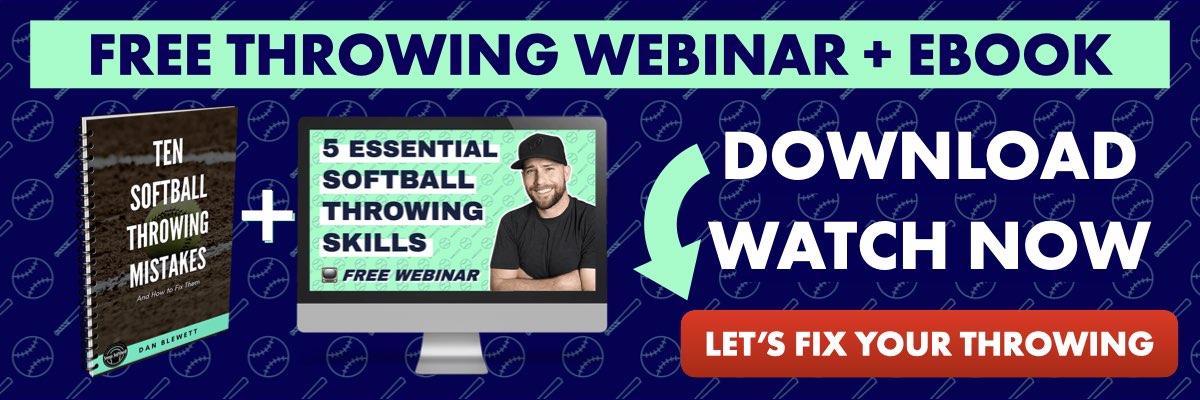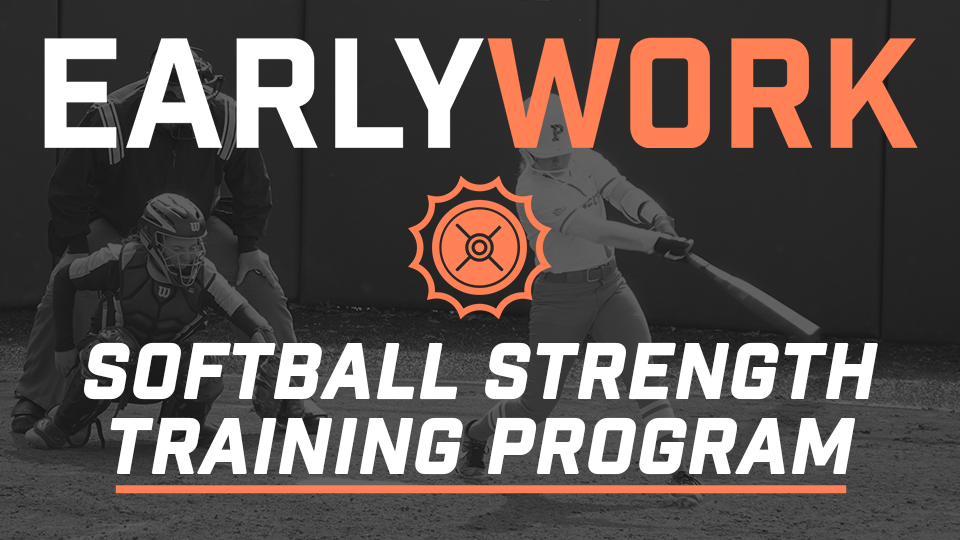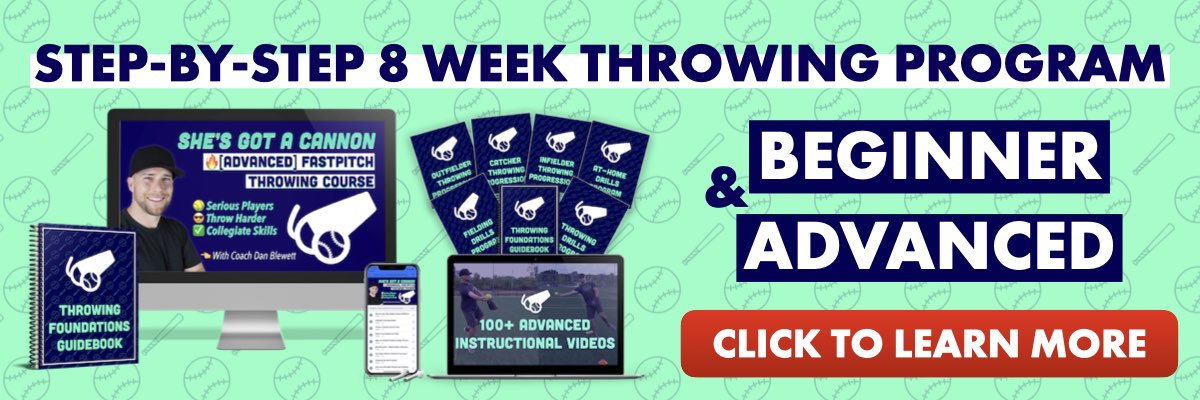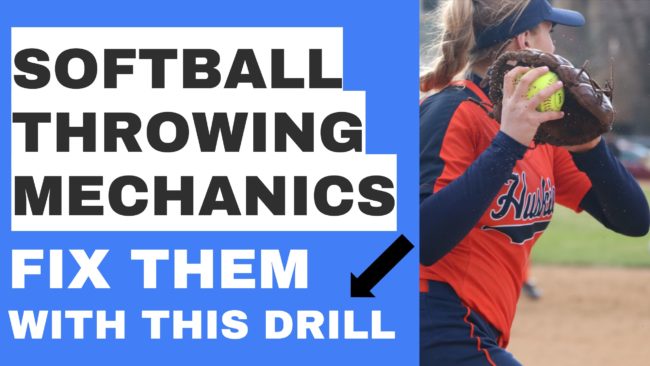*This article may contain product links which pay me a small commission if you make a purchase. Learn more.
Softball throwing drills can make a big difference in a player’s throwing velocity. In this article, you’ll learn two of the best drills that are both easy to perform and great for longterm throwing routines.
First: How does your throwing speed stack up?
Check out the video below to see a breakdown of softball throwing velocity by age.
For serious fastpitch players, they should make a goal to gain 3-5 miles per hour per year, which is realistic with hard work and a focus on learning every throwing drill and getting better at each over time.
If you want a shortcut, step-by-step throwing program, check out my two free throwing resources below.

With anything, practices makes perfect and no drill is a magic pill that will fix a player over night. But, with consistent focus and using many of the drills found below, players can make consistent improvements until they throw at least in the low 60s. Average throwing speed for a collegiate softball player is in the 56-64 range, so getting to the 60mph mark is key. These drills below will help!
Use this Table of Contents to Skip Ahead
- Use this Table of Contents to Skip Ahead
- First: A Great Video on Softball Throwing Mechanics
- Why Softball Throwing Drills From the Past Aren't Very Effective
- 1 | The Lawnmower Throwing Drill for Softball
- 2 | The Swing-Shuffle Drill
- What a Good Throwing Drill Routine Looks Like
- Bonus Video & Playlist for Softball Players and Coaches
- Softball Throwing Mechanics & Drills FAQ
Use the table of contents to skip ahead in this article.
First: A Great Video on Softball Throwing Mechanics
This video is a great step-by-step demonstration of the major points in the throwing motion.
Be sure to watch the video above to learn the WHY behind all the drills below.
And, if you’re a beginner, start with this video on softball infield fielding technique, with tips and drills for slow pitch and fastpitch players:
Why Softball Throwing Drills From the Past Aren’t Very Effective
There are a LOT of old throwing drills in softball that just keep getting passed down from generation to generation. Few coaches and players are pushing back and challenging this old knowledge. More of us need to be asking why we are doing this drill.
More of us need to be asking: Why we are doing this drill? What purpose does it serve? What does it improve?
In the baseball world, millions upon millions of dollars are being poured into helping young men throw faster. Why? Because there are million-dollar payouts for the best arms in the country every time the MLB draft rolls around. 20 million dollar pitching contracts are becoming the norm for average Big League pitchers.
So, let’s take some lessons from baseball, and use some of the best drills that are producing elite-level softball throwers.
Want to Throw at an Elite Level? It Starts in the Pregame Routine
This drill, the Lawnmower Drill, helps create the proper joint angle in the elbow and the proper timing of the delivery, so that the hips sync up better with the arm.
It’s one of the first drills you should be doing in a throwing progression, and I do it with nearly EVERY player I work with.
1 | The Lawnmower Throwing Drill for Softball
This one is a great throwing drill for working on pulling the shoulder blades back, which helps prevent “pushing” the ball later on in the throwing motion.
Most softball players don’t retract (pinch) their shoulder blades well, which is an integral part of getting the arm to “hitch up” to the train of power made up by the core and hips. The lawnmower drill helps to teach the shoulder blade pinch and increase the use of the core and hips.
2 | The Swing-Shuffle Drill
This is one of my favorite long toss drills for softball players. It really encourages players to use the legs and helps them improve the action of their glove arm and front side.
Many players have faulty arm swings and don’t stay closed well, so this drill is a big help with both of those items as well. It’s very smooth and is my go-to when players begin to get farther away from each other (at least 60ft away). Give it a try!
Integrate these Softball Throwing Drills Into Your Pregame Routine.
Even one throwing drill for softball can make a big difference if it connects with the player and helps her understand her mechanics better. Part of being a good thrower is understanding how the body works together–it’s not just the legs, arm or any other body part–they’re all connected.
What a Good Throwing Drill Routine Looks Like
Every throw counts! I cannot say this enough: EVERY. THROW. COUNTS.
If you’re a player and you give away throws by not focusing on improving your mechanics with every single throw, other girls are catching up to you and passing you. Your routine of softball throwing drills is critical to your longterm goals. Here’s a sample throwing routine into which you can insert your own drills:
- Lawnmower Drill – 10 Throws @ 30 feet
- Rocker Drill – 10 Throws @ 40 feet
- Infield Footwork Throws – 15 Throws @ 50 feet
- Swing-Shuffle Drill – 10 Throws @ 55-90 feet (move back slowly)
- Outfield Footwork Throws – 10 Throws @ 90-120 feet
- Fast Shuffle Throws – 10 Throws @ 60 feet (come back in)
Bonus Video & Playlist for Softball Players and Coaches
Click here or start the video below to view my “Master These Softball Throwing Basics” YouTube playlist. This is an important collection of my fundamental drills every player and coach should be using.
And coaches, again, challenge yourself to answer the following question: Why am I giving these drills to my players?
Every drill must have a purpose, and the purpose should be easy to explain to anyone who asks. Most throwing routines do not pass this criteria.
Become a Hard-Throwing Softball Player
Want a softball strength training program you can start today? Try Early Work, my new program.
Need a Great
Softball Workout Plan?
Versions for all ages with a 14-Day Free Trial

You’re here because you want to learn how to throw harder with more accuracy, right? If so, don’t leave more free information on the table. Download my free Throwing eBook now.
I also offer an extensive online course called She’s Got a Cannon. It will take you through everything you need to do to throw harder: knowledge, softball throwing drills, evaluation, video analysis, etc.

This program is perfect for coaches and serious players who want to make major, longterm improvements in their throwing mechanics.
Check Out My Podcast – Good Advice
With weekly tips for players, parent and softball coaches.
Softball Throwing Mechanics & Drills FAQ
How do you correct a throwing motion in softball?
This can be very difficult! Start with softball throwing drills that work on the timing of the hand break, which causes a lot of arm action issues because the body gets into a bad rhythm in how the hands work with the lower body. Having a routine of great drills that teach proper front side mechanics, proper weight shift and a good arm action are all very important.
How do you teach a girl to throw a softball?
Here’s the step by step process:
1. Teach fielding fundamentals, including “funneling” a ground ball and how to crowhop after fielding a ball.
2. Work on the timing of the hand break – how the hands separate from the glove
3. Teach the arm action, including the joint angle at the elbow (which should be less than 90 degrees)
4. Work on the front side, which helps rotate the body and accelerate the arm starting with the hips
5. Establish a great routine of softball throwing drills that can be performed at home and before every practice
How do you fix a short arm throw?
Short arm throwing is a bit of a misunderstood concept, but it basically means that the elbow tends to dip, rather than accelerating above the ball. When the torso is not connected to the arm–meaning its not accelerating in the proper sequence–the arm tends to jump ahead of the torso and “pushes” the ball. This pushing is what we usually call short-arming.
What's a good softball throwing drill for before games?
I highly recommend NOT doing wrist snaps, and instead working a lot on infield, catching or outfield footwork as a major part of the throwing routine. Before games, players should be working on throwing mechanics but also on the game actions they’ll use at their position.

